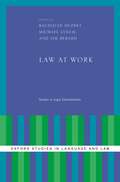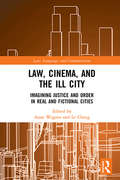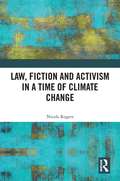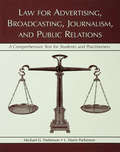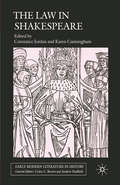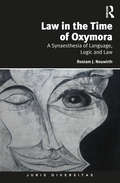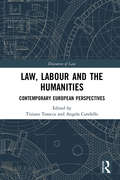- Table View
- List View
Law as if Earth Really Mattered: The Wild Law Judgment Project (Law, Justice and Ecology)
by Nicole Rogers Michelle MaloneyThis book is a collection of judgments drawn from the innovative Wild Law Judgment Project. In participating in the Wild Law Judgment Project, which was inspired by various feminist judgment projects, contributors have creatively reinterpreted judicial decisions from an Earth-centred point of view by rewriting existing judgments, or creating fictional judgments, as wild law. Authors have confronted the specific challenges of aligning existing Western legal systems with Thomas Berry’s philosophy of Earth jurisprudence through judgment writing and rewriting. This book thus opens up judicial decision-making and the common law to critical scrutiny from a wild law or Earth-centred perspective. Based upon ecocentric rather than human-centred or anthropocentric principles, Earth jurisprudence poses a unique critical challenge to the dominant anthropocentric or human-centred focus and orientation of the common law. The authors interrogate the anthropocentric and property rights assumptions embedded in existing common law by placing Earth and the greater community of life at the centre of their rewritten and hypothetical judgments. Covering areas as diverse as tort law, intellectual property law, criminal law, environmental law, administrative law, international law, native title law and constitutional law, this unique collection provides a valuable tool for practitioners and students who are interested in learning more about the emerging ecological jurisprudence movement. It helps us to see more clearly what a new system of law might look like: one in which Earth really matters.
Law as if Earth Really Mattered: The Wild Law Judgment Project (Law, Justice and Ecology)
by Nicole Rogers Michelle MaloneyThis book is a collection of judgments drawn from the innovative Wild Law Judgment Project. In participating in the Wild Law Judgment Project, which was inspired by various feminist judgment projects, contributors have creatively reinterpreted judicial decisions from an Earth-centred point of view by rewriting existing judgments, or creating fictional judgments, as wild law. Authors have confronted the specific challenges of aligning existing Western legal systems with Thomas Berry’s philosophy of Earth jurisprudence through judgment writing and rewriting. This book thus opens up judicial decision-making and the common law to critical scrutiny from a wild law or Earth-centred perspective. Based upon ecocentric rather than human-centred or anthropocentric principles, Earth jurisprudence poses a unique critical challenge to the dominant anthropocentric or human-centred focus and orientation of the common law. The authors interrogate the anthropocentric and property rights assumptions embedded in existing common law by placing Earth and the greater community of life at the centre of their rewritten and hypothetical judgments. Covering areas as diverse as tort law, intellectual property law, criminal law, environmental law, administrative law, international law, native title law and constitutional law, this unique collection provides a valuable tool for practitioners and students who are interested in learning more about the emerging ecological jurisprudence movement. It helps us to see more clearly what a new system of law might look like: one in which Earth really matters.
Law as Performance: Theatricality, Spectatorship, and the Making of Law in Ancient, Medieval, and Early Modern Europe (Law and Literature)
by Julie Stone PetersTirades against legal theatrics are nearly as old as law itself, and yet so is the age-old claim that law must not merely be done: it must be "seen to be done." Law as Performance traces the history of legal performance and spectatorship through the early modern period. Viewing law as the product not merely of edicts or doctrines but of expressive action, it investigates the performances that literally created law: in civic arenas, courtrooms, judges' chambers, marketplaces, scaffolds, and streets. It examines the legal codes, learned treatises, trial reports, lawyers' manuals, execution narratives, rhetoric books, images (and more) that confronted these performances, praising their virtues or denouncing their evils. In so doing, it recovers a long, rich, and largely overlooked tradition of jurisprudential thought about law as a performance practice. This tradition not only generated an elaborate poetics and politics of legal performance. It provided western jurisprudence with a set of constitutive norms that, in working to distinguish law from theatrics, defined the very nature of law. In the crucial opposition between law and theatre, law stood for cool deliberation, by-the-book rules, and sovereign discipline. Theatre stood for deceptive artifice, entertainment, histrionics, melodrama. And yet legal performance, even at its most theatrical, also appeared fundamental to law's realization: a central mechanism for shaping legal subjects, key to persuasion, essential to deterrence, indispensable to law's power, —as it still does today.
Law as Performance: Theatricality, Spectatorship, and the Making of Law in Ancient, Medieval, and Early Modern Europe (Law and Literature)
by Julie Stone PetersTirades against legal theatrics are nearly as old as law itself, and yet so is the age-old claim that law must not merely be done: it must be "seen to be done." Law as Performance traces the history of legal performance and spectatorship through the early modern period. Viewing law as the product not merely of edicts or doctrines but of expressive action, it investigates the performances that literally created law: in civic arenas, courtrooms, judges' chambers, marketplaces, scaffolds, and streets. It examines the legal codes, learned treatises, trial reports, lawyers' manuals, execution narratives, rhetoric books, images (and more) that confronted these performances, praising their virtues or denouncing their evils. In so doing, it recovers a long, rich, and largely overlooked tradition of jurisprudential thought about law as a performance practice. This tradition not only generated an elaborate poetics and politics of legal performance. It provided western jurisprudence with a set of constitutive norms that, in working to distinguish law from theatrics, defined the very nature of law. In the crucial opposition between law and theatre, law stood for cool deliberation, by-the-book rules, and sovereign discipline. Theatre stood for deceptive artifice, entertainment, histrionics, melodrama. And yet legal performance, even at its most theatrical, also appeared fundamental to law's realization: a central mechanism for shaping legal subjects, key to persuasion, essential to deterrence, indispensable to law's power, —as it still does today.
Law at Work: Studies in Legal Ethnomethods (Oxford Studies in Language and Law)
by Baudouin Dupret, Michael Lynch and Tim BerardThe studies in this volume use ethnographic, ethnomethodological, and sociolinguistic research to demonstrate how legal agents conduct their practices and exercise their authority in relation to non-expert participants and broader publics. Instead of treating law as a body of doctrines, or law and society as a relationship between legal institutions and an external society, the studies in this volume closely examine law at work: specific legal practices and social interactions produced in national and international settings. These settings include courtrooms and other tribunals, consultations between lawyers and clients, and media forums in which government officials address international law. Because law is a public institution, and legal actions are publicly accountable, technical law must interface with non-expert members of the public. The embodied actions and interactions that comprise the interface between professional and lay participants in legal settings therefore must do justice to legal traditions and statutory obligations while also contending with mundane interactional routines, ordinary reasoning, and popular expectations. Specific chapters examine topics such as family disputes in a system of Sharia Law; rhetorical contestations about possible violations of international law during a violent conflict in the Middle-East; the transformation of a courtroom hearing brought about by the virtual presence of remote witnesses relayed through a video link; the practices through which written records are used to mediate and leverage a witness's testimony; and the discursive and interactional practices through which authorized parties use legal categories to problems with individual conduct. Each chapter shows that it makes a profound difference to the way we understand the law when we examine its meaning and application in practice.
Law at Work: Studies in Legal Ethnomethods (Oxford Studies in Language and Law)
by Baudouin Dupret Michael Lynch Tim BerardThe studies in this volume use ethnographic, ethnomethodological, and sociolinguistic research to demonstrate how legal agents conduct their practices and exercise their authority in relation to non-expert participants and broader publics. Instead of treating law as a body of doctrines, or law and society as a relationship between legal institutions and an external society, the studies in this volume closely examine law at work: specific legal practices and social interactions produced in national and international settings. These settings include courtrooms and other tribunals, consultations between lawyers and clients, and media forums in which government officials address international law. Because law is a public institution, and legal actions are publicly accountable, technical law must interface with non-expert members of the public. The embodied actions and interactions that comprise the interface between professional and lay participants in legal settings therefore must do justice to legal traditions and statutory obligations while also contending with mundane interactional routines, ordinary reasoning, and popular expectations. Specific chapters examine topics such as family disputes in a system of Sharia Law; rhetorical contestations about possible violations of international law during a violent conflict in the Middle-East; the transformation of a courtroom hearing brought about by the virtual presence of remote witnesses relayed through a video link; the practices through which written records are used to mediate and leverage a witness's testimony; and the discursive and interactional practices through which authorized parties use legal categories to problems with individual conduct. Each chapter shows that it makes a profound difference to the way we understand the law when we examine its meaning and application in practice.
Law, Cinema, and the Ill City: Imagining Justice and Order in Real and Fictional Cities (Law, Language and Communication)
by Anne Wagner Le ChengThis book uses film and television as a resource for addressing the social and legal ills of the city. It presents a range of approaches to view the ill city through cinematic and televisual characterization in urban frameworks, political contexts, and cultural settings. Each chapter deconstructs the meaning of urban space as public space while critically generating a focus on order and justice, exploring issues such as state disorder, lawlessness, and revenge. The approach presents a careful balance between theory and application. The original and novel ideas presented in this book will be essential reading for those interested in the presentation of law and place in cultural texts such as film.
Law, Cinema, and the Ill City: Imagining Justice and Order in Real and Fictional Cities (Law, Language and Communication)
by Anne Wagner Le ChengThis book uses film and television as a resource for addressing the social and legal ills of the city. It presents a range of approaches to view the ill city through cinematic and televisual characterization in urban frameworks, political contexts, and cultural settings. Each chapter deconstructs the meaning of urban space as public space while critically generating a focus on order and justice, exploring issues such as state disorder, lawlessness, and revenge. The approach presents a careful balance between theory and application. The original and novel ideas presented in this book will be essential reading for those interested in the presentation of law and place in cultural texts such as film.
Law Dissertations: A Step-by-Step Guide
by Laura LammasniemiLaw Dissertations: A Step-by-Step Guide provides you with all the guidance and information you need to complete and succeed in your LLB, LLM or law-related dissertation. Written in a simple, clear format and with plenty of tools to help you to put the theory into practice, Laura Lammasniemi will show you how to make writing your law dissertation easy, without compromising intellectual rigour. As well as explaining the process of research and outlining the various legal methodologies, the book also provides practical, step-by-step guidance on how to formulate a proposal, research plan, and literature review. Unlike other law research skills books, it includes a section on empirical research methodology and ethics for the benefit of students who are studying for a law-related degree. Packed full of exercises, worked examples and tools for self-evaluation, this book is sure to become your essential guide, supporting you on every step of your journey in writing your law dissertation.
Law Dissertations: A Step-by-Step Guide
by Laura LammasniemiLaw Dissertations: A Step-by-Step Guide provides you with all the guidance and information you need to complete and succeed in your LLB, LLM or law-related dissertation. Written in a simple, clear format and with plenty of tools to help you to put the theory into practice, Laura Lammasniemi will show you how to make writing your law dissertation easy, without compromising intellectual rigour. As well as explaining the process of research and outlining the various legal methodologies, the book also provides practical, step-by-step guidance on how to formulate a proposal, research plan, and literature review. Unlike other law research skills books, it includes a section on empirical research methodology and ethics for the benefit of students who are studying for a law-related degree. Packed full of exercises, worked examples and tools for self-evaluation, this book is sure to become your essential guide, supporting you on every step of your journey in writing your law dissertation.
Law Dissertations: A Step-by-Step Guide
by Laura LammasniemiLaw Dissertations: A Step-by-Step Guide provides law students with all the guidance and information they need to complete and succeed in their LLB, LLM or law-related dissertation. Written in an accessible, clear format and with plenty of tools to help put the theory into practice, Laura Lammasniemi will show students how to make writing a law dissertation easy, without compromising intellectual rigour. The primary aim of this book is to tackle the issues that cause anxiety to law students undertaking a dissertation so that they can focus on the research that you find exciting. As well as explaining the process of research and outlining the various legal research approaches, the book also provides practical, step-by-step guidance on how to formulate a proposal, research plan, and literature review. The second edition expands guidance to LLM and Masters students, and provides up-todate guidance on how to complete your project using both online resources and remotely. Unlike other law research skills books, Law Dissertations: A Step-by-Step Guide includes a section on empirical research methodology and ethics for the benefit of students who are studying for a Masters in law. Packed full of exercises, worked examples, and tools for self-evaluation, this book is sure to become an essential guide for law students, supporting them on every step of their dissertation journey.
Law Dissertations: A Step-by-Step Guide
by Laura LammasniemiLaw Dissertations: A Step-by-Step Guide provides law students with all the guidance and information they need to complete and succeed in their LLB, LLM or law-related dissertation. Written in an accessible, clear format and with plenty of tools to help put the theory into practice, Laura Lammasniemi will show students how to make writing a law dissertation easy, without compromising intellectual rigour. The primary aim of this book is to tackle the issues that cause anxiety to law students undertaking a dissertation so that they can focus on the research that you find exciting. As well as explaining the process of research and outlining the various legal research approaches, the book also provides practical, step-by-step guidance on how to formulate a proposal, research plan, and literature review. The second edition expands guidance to LLM and Masters students, and provides up-todate guidance on how to complete your project using both online resources and remotely. Unlike other law research skills books, Law Dissertations: A Step-by-Step Guide includes a section on empirical research methodology and ethics for the benefit of students who are studying for a Masters in law. Packed full of exercises, worked examples, and tools for self-evaluation, this book is sure to become an essential guide for law students, supporting them on every step of their dissertation journey.
Law, Fiction and Activism in a Time of Climate Change
by Nicole RogersThe book examines the narratives of climate change which have developed and which are currently evolving in three areas: law, fiction and activism. Narratives of climate change generated by litigants, judges, writers of fiction and activists are having, and will have, a profound effect on the way we respond to the climate change crisis. Acknowledging the prevalence of unreliable narrators, this book explores the reliability and significance of different forms of climate narrative. The author analyses overlapping themes and points of intersection, considering the recurrent motif of the trickster, the prominence of the child, the significance and ongoing viability of the rights discourse, and the increasingly prevalent emergency framing with its multiple implications for law’s empire. She asks how law, fiction and activism measure up as textual and performative fora for telling the story of climate change and anticipating a climate-changed future. And, in addition, how can they help foster transformative narratives which empower us to confront the climate change crisis? This highly topical, cross-disciplinary work will be of interest to anyone concerned about the growing climate emergency and makes a valuable contribution to climate law, environmental law, the environmental humanities and ecocriticism.
Law, Fiction and Activism in a Time of Climate Change
by Nicole RogersThe book examines the narratives of climate change which have developed and which are currently evolving in three areas: law, fiction and activism. Narratives of climate change generated by litigants, judges, writers of fiction and activists are having, and will have, a profound effect on the way we respond to the climate change crisis. Acknowledging the prevalence of unreliable narrators, this book explores the reliability and significance of different forms of climate narrative. The author analyses overlapping themes and points of intersection, considering the recurrent motif of the trickster, the prominence of the child, the significance and ongoing viability of the rights discourse, and the increasingly prevalent emergency framing with its multiple implications for law’s empire. She asks how law, fiction and activism measure up as textual and performative fora for telling the story of climate change and anticipating a climate-changed future. And, in addition, how can they help foster transformative narratives which empower us to confront the climate change crisis? This highly topical, cross-disciplinary work will be of interest to anyone concerned about the growing climate emergency and makes a valuable contribution to climate law, environmental law, the environmental humanities and ecocriticism.
Law for Advertising, Broadcasting, Journalism, and Public Relations: Law for Advertising, Broadcasting, Journalism, and Public Relations
by Michael G. Parkinson L. Marie ParkinsonThis exceptional new text offers an up-to-date and integrated approach to communication law. Written by two practicing attorneys with extensive experience teaching the communication law course, Law for Advertising, Broadcasting, Journalism, and Public Relations covers the areas of communication law essential and most relevant for readers throughout the communication curriculum. Its integrated approach will serve students and practitioners in advertising and public relations as well as those in journalism and electronic media.Providing background to help readers understand legal concepts, this comprehensive communication law text includes an introduction to the legal system; covers legal procedures, structures, and jurisdictions; discusses the First Amendment and electronic media regulations; and considers issues of access. Additional material includes: *intellectual property law; *employment and agency law, with explanations of how these laws create obligations for mass communication professionals and their employees; *commercial communication laws; and *special laws and regulations that impact reporters, public relations practitioners, and advertisers who deal with stock sales.Special features of this text include:*Magic Words and Phrases--defining legal terms;*Cases--illustrating key points in each chapter;*Practice Notes--highlighting points of particular interest to professional media practices;*Instructions on finding and briefing cases, with a sample brief; and*Examples of legal documents and jury instructions.This text is intended as an introduction to communication law for students and practitioners in mass communication, journalism, advertising, broadcasting, telecommunications, and public relations.
Law for Advertising, Broadcasting, Journalism, and Public Relations: Law for Advertising, Broadcasting, Journalism, and Public Relations
by Michael G. Parkinson L. Marie ParkinsonThis exceptional new text offers an up-to-date and integrated approach to communication law. Written by two practicing attorneys with extensive experience teaching the communication law course, Law for Advertising, Broadcasting, Journalism, and Public Relations covers the areas of communication law essential and most relevant for readers throughout the communication curriculum. Its integrated approach will serve students and practitioners in advertising and public relations as well as those in journalism and electronic media.Providing background to help readers understand legal concepts, this comprehensive communication law text includes an introduction to the legal system; covers legal procedures, structures, and jurisdictions; discusses the First Amendment and electronic media regulations; and considers issues of access. Additional material includes: *intellectual property law; *employment and agency law, with explanations of how these laws create obligations for mass communication professionals and their employees; *commercial communication laws; and *special laws and regulations that impact reporters, public relations practitioners, and advertisers who deal with stock sales.Special features of this text include:*Magic Words and Phrases--defining legal terms;*Cases--illustrating key points in each chapter;*Practice Notes--highlighting points of particular interest to professional media practices;*Instructions on finding and briefing cases, with a sample brief; and*Examples of legal documents and jury instructions.This text is intended as an introduction to communication law for students and practitioners in mass communication, journalism, advertising, broadcasting, telecommunications, and public relations.
The Law in Shakespeare (Early Modern Literature in History)
by C. Jordan K. CunninghamLeading scholars in the field analyze Shakespeare's plays to show how their dramatic content shapes issues debated in conflicts arising from the creation and application of law. Individual essays focus on such topics such as slander, revenge, and royal prerogative; these studies reveal the problems confronting early modern English men and women.
Law in the Time of Oxymora: A Synaesthesia of Language, Logic and Law (Juris Diversitas)
by Rostam J. NeuwirthWhat do different concepts like true lie, bad luck, honest thief, old news, spacetime, glocalization, symplexity, sustainable development, constant change, soft law, substantive due process, pure law, bureaucratic efficiency and global justice have in common? What connections do they share with innumerable paradoxes, like the ones of happiness, time, globalization, sex, and of free will and fate? Law in the Time of Oxymora provides answers to these conundrums by critically comparing the apparent rise in recent years of the use of rhetorical figures called "essentially oxymoronic concepts" (i.e. oxymoron, enantiosis and paradoxes) in the areas of art, science and law. Albeit to varying degrees, these concepts share the quality of giving expression to apparent contradictions. Through this quality, they also challenge the scientific paradigm rooted in the dualistic thinking and binary logic that is traditionally used in the West, as opposed to the East, where a paradoxical mode of thinking and fuzzy logic is said to have been cultivated. Following a review of oxymora and paradoxes in art and various scientific writings, hundreds of "hard cases" featuring oxymora and a comprehensive review of the legal literature are discussed, revealing evidence suggesting that the present scientific paradigm of dualism alone will no longer be able to tackle the challenges arising from increasing diversity and complexity coupled with an apparent acceleration of change. Law in the Time of Oxymora reaches the surprising conclusion that essentially oxymoronic concepts may inaugurate a new era of cognition, involving the ways the senses interact and how we reason, think and make decisions in law and in life.
Law in the Time of Oxymora: A Synaesthesia of Language, Logic and Law (Juris Diversitas)
by Rostam J. NeuwirthWhat do different concepts like true lie, bad luck, honest thief, old news, spacetime, glocalization, symplexity, sustainable development, constant change, soft law, substantive due process, pure law, bureaucratic efficiency and global justice have in common? What connections do they share with innumerable paradoxes, like the ones of happiness, time, globalization, sex, and of free will and fate? Law in the Time of Oxymora provides answers to these conundrums by critically comparing the apparent rise in recent years of the use of rhetorical figures called "essentially oxymoronic concepts" (i.e. oxymoron, enantiosis and paradoxes) in the areas of art, science and law. Albeit to varying degrees, these concepts share the quality of giving expression to apparent contradictions. Through this quality, they also challenge the scientific paradigm rooted in the dualistic thinking and binary logic that is traditionally used in the West, as opposed to the East, where a paradoxical mode of thinking and fuzzy logic is said to have been cultivated. Following a review of oxymora and paradoxes in art and various scientific writings, hundreds of "hard cases" featuring oxymora and a comprehensive review of the legal literature are discussed, revealing evidence suggesting that the present scientific paradigm of dualism alone will no longer be able to tackle the challenges arising from increasing diversity and complexity coupled with an apparent acceleration of change. Law in the Time of Oxymora reaches the surprising conclusion that essentially oxymoronic concepts may inaugurate a new era of cognition, involving the ways the senses interact and how we reason, think and make decisions in law and in life.
The Law Is a White Dog: How Legal Rituals Make and Unmake Persons
by Colin DayanAbused dogs, prisoners tortured in Guantánamo and supermax facilities, or slaves killed by the state--all are deprived of personhood through legal acts. Such deprivations have recurred throughout history, and the law sustains these terrors and banishments even as it upholds the civil order. Examining such troubling cases, The Law Is a White Dog tackles key societal questions: How does the law construct our identities? How do its rules and sanctions make or unmake persons? And how do the supposedly rational claims of the law define marginal entities, both natural and supernatural, including ghosts, dogs, slaves, terrorist suspects, and felons? Reading the language, allusions, and symbols of legal discourse, and bridging distinctions between the human and nonhuman, Colin Dayan looks at how the law disfigures individuals and animals, and how slavery, punishment, and torture create unforeseen effects in our daily lives. Moving seamlessly across genres and disciplines, Dayan considers legal practices and spiritual beliefs from medieval England, the North American colonies, and the Caribbean that have survived in our legal discourse, and she explores the civil deaths of felons and slaves through lawful repression. Tracing the legacy of slavery in the United States in the structures of the contemporary American prison system and in the administrative detention of ghostly supermax facilities, she also demonstrates how contemporary jurisprudence regarding cruel and unusual punishment prepared the way for abuses in Abu Ghraib and Guantánamo. Using conventional historical and legal sources to answer unconventional questions, The Law Is a White Dog illuminates stark truths about civil society's ability to marginalize, exclude, and dehumanize.
The Law Is a White Dog: How Legal Rituals Make and Unmake Persons
by Colin DayanAbused dogs, prisoners tortured in Guantánamo and supermax facilities, or slaves killed by the state--all are deprived of personhood through legal acts. Such deprivations have recurred throughout history, and the law sustains these terrors and banishments even as it upholds the civil order. Examining such troubling cases, The Law Is a White Dog tackles key societal questions: How does the law construct our identities? How do its rules and sanctions make or unmake persons? And how do the supposedly rational claims of the law define marginal entities, both natural and supernatural, including ghosts, dogs, slaves, terrorist suspects, and felons? Reading the language, allusions, and symbols of legal discourse, and bridging distinctions between the human and nonhuman, Colin Dayan looks at how the law disfigures individuals and animals, and how slavery, punishment, and torture create unforeseen effects in our daily lives. Moving seamlessly across genres and disciplines, Dayan considers legal practices and spiritual beliefs from medieval England, the North American colonies, and the Caribbean that have survived in our legal discourse, and she explores the civil deaths of felons and slaves through lawful repression. Tracing the legacy of slavery in the United States in the structures of the contemporary American prison system and in the administrative detention of ghostly supermax facilities, she also demonstrates how contemporary jurisprudence regarding cruel and unusual punishment prepared the way for abuses in Abu Ghraib and Guantánamo. Using conventional historical and legal sources to answer unconventional questions, The Law Is a White Dog illuminates stark truths about civil society's ability to marginalize, exclude, and dehumanize.
Law, Labour and the Humanities: Contemporary European Perspectives
by Tiziano Toracca Angela CondelloThe ontology of work and the economics of value underpin the legal institution, with the existence of modern law predicated upon the subject as labourer. In contemporary Europe, labour is more than a mere economic relationship. Indeed, labour occupies a central position in human existence: since the industrial revolution, it has been the principal criterion of reciprocal recognition and of universal mobilization. This multi-disciplinary volume analyses labour and its depictions in their interaction with the latest legal, socio-economic, political and artistic tendencies. Addressing such issues as deregulation, flexibility, de-industrialization, the pervasive enlargement of markets, digitization and virtual relationships, social polarisation and migratory fluxes, this volume engages with the existential role played by labour in our lives at the conjunction of law and the humanities. This book will be of interest to law students, legal philosophers, theoretical philosophers, political philosophers, social and political theorists, labour studies scholars, and literature and film scholars.
Law, Labour and the Humanities: Contemporary European Perspectives
by Tiziano Toracca Angela CondelloThe ontology of work and the economics of value underpin the legal institution, with the existence of modern law predicated upon the subject as labourer. In contemporary Europe, labour is more than a mere economic relationship. Indeed, labour occupies a central position in human existence: since the industrial revolution, it has been the principal criterion of reciprocal recognition and of universal mobilization. This multi-disciplinary volume analyses labour and its depictions in their interaction with the latest legal, socio-economic, political and artistic tendencies. Addressing such issues as deregulation, flexibility, de-industrialization, the pervasive enlargement of markets, digitization and virtual relationships, social polarisation and migratory fluxes, this volume engages with the existential role played by labour in our lives at the conjunction of law and the humanities. This book will be of interest to law students, legal philosophers, theoretical philosophers, political philosophers, social and political theorists, labour studies scholars, and literature and film scholars.
Law, Language and the Courtroom: Legal Linguistics and the Discourse of Judges (Law, Language and Communication)
by Stanisław Goźdź-Roszkowski Gianluca PontrandolfoThis book explores the language of judges. It is concerned with understanding how language works in judicial contexts. Using a range of disciplinary and methodological perspectives, it looks in detail at the ways in which judicial discourse is argued, constructed, interpreted and perceived. Focusing on four central themes - constructing judicial discourse and judicial identities, judicial argumentation and evaluative language, judicial interpretation, and clarity in judicial discourse - the book’s ultimate goal is to provide a comprehensive and in-depth analysis of current critical issues of the role of language in judicial settings. Contributors include legal linguists, lawyers, legal scholars, legal practitioners, legal translators and anthropologists, who explore patterns of linguistic organisation and use in judicial institutions and analyse language as an instrument for understanding both the judicial decision-making process and its outcome. The book will be an invaluable resource for scholars in legal linguistics and those specialising in judicial argumentation and reasoning ,and forensic linguists interested in the use of language in judicial settings.
Law, Language and the Courtroom: Legal Linguistics and the Discourse of Judges (Law, Language and Communication)
by Stanislaw Gozdz Roszkowski Gianluca PontrandolfoThis book explores the language of judges. It is concerned with understanding how language works in judicial contexts. Using a range of disciplinary and methodological perspectives, it looks in detail at the ways in which judicial discourse is argued, constructed, interpreted and perceived. Focusing on four central themes - constructing judicial discourse and judicial identities, judicial argumentation and evaluative language, judicial interpretation, and clarity in judicial discourse - the book’s ultimate goal is to provide a comprehensive and in-depth analysis of current critical issues of the role of language in judicial settings. Contributors include legal linguists, lawyers, legal scholars, legal practitioners, legal translators and anthropologists, who explore patterns of linguistic organisation and use in judicial institutions and analyse language as an instrument for understanding both the judicial decision-making process and its outcome. The book will be an invaluable resource for scholars in legal linguistics and those specialising in judicial argumentation and reasoning ,and forensic linguists interested in the use of language in judicial settings.


